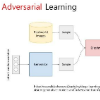In this letter, we aim to address a synthetic aperture radar (SAR) despeckling problem with the necessity of neither clean (speckle-free) SAR images nor independent speckled image pairs from the same scene, and a practical solution for SAR despeckling (PSD) is proposed. First, an adversarial learning framework is designed to generate speckled-to-speckled (S2S) image pairs from the same scene in the situation where only single speckled SAR images are available. Then, the S2S SAR image pairs are employed to train a modified despeckling Nested-UNet model using the Noise2Noise (N2N) strategy. Moreover, an iterative version of the PSD method (PSDi) is also presented. Experiments are conducted on both synthetic speckled and real SAR data to demonstrate the superiority of the proposed methods compared with several state-of-the-art methods. The results show that our methods can reach a good tradeoff between feature preservation and speckle suppression.
翻译:在这封信中,我们力求解决合成孔径雷达(SAR)脱钩问题,因为既非清洁(无斑点)合成孔径雷达(SAR)图像,也非来自同一场景的独立斑点图像配对的必要性,并提出了合成孔径雷达脱光(PSD)的实用解决办法。首先,设计了一个对抗性学习框架,目的是在只有单一斑点合成孔径雷达图像的情况下,从同一场景产生聚变至斑点(S2S)图像配对。然后,S2SAS合成孔径雷达图像配对被用来用噪音2噪音(N2N)战略来训练一个经过修改的脱光的探光(Nessted-UNet)模型。此外,还介绍了私营部门司方法的迭代版本。对合成斑点和真实的合成孔径雷达数据进行了实验,以显示拟议方法与若干最新方法相比的优势。结果显示,我们的方法可以在特征保护与按点抑制之间实现良好的平衡。



